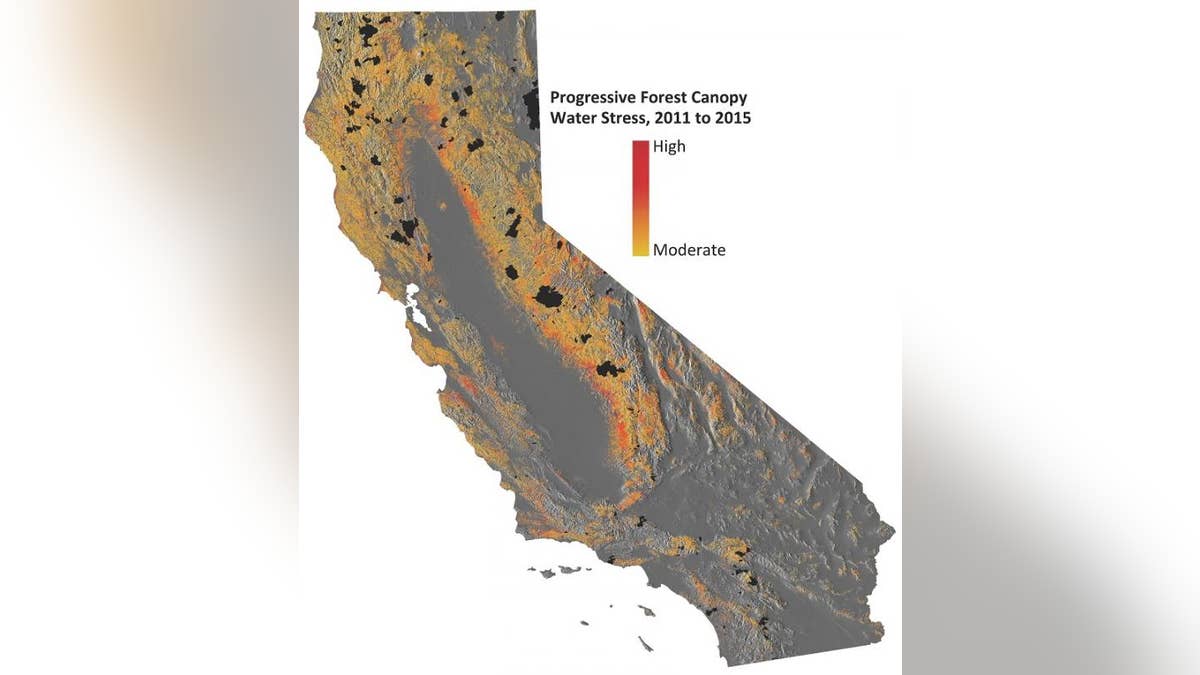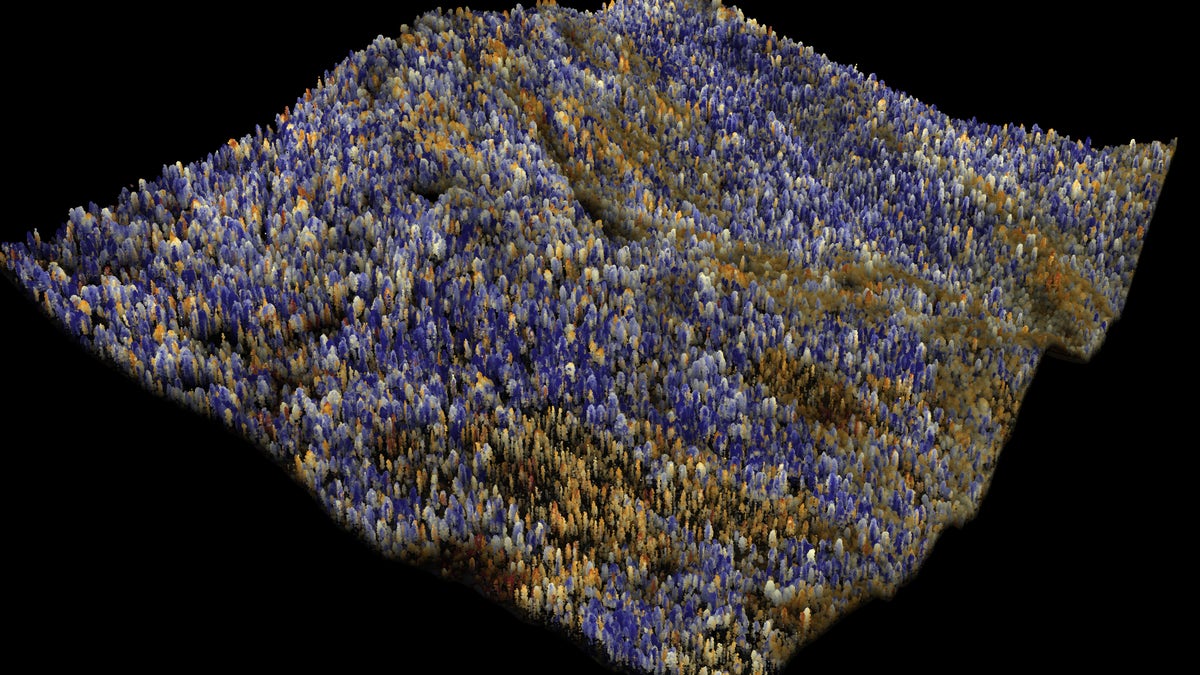
This image shows progressive water stress on California's forests. (Courtesty of Greg Asner
California’s drought has drained lakes, caused land to subside and forced the state to enact draconian water rules.
Now, a new study find the years of little or no rain is taking a heavy toll on the state’s forests.
The researchers at Stanford University’s Carnegie Institution for Science concluded that up to 58 million large trees in California experienced water loss that could be life threatening since 2011 due to the state's historic drought. Coupled with higher temperatures and insect outbreaks including from the destructive bark beetle, the drought is increasing the risk of the trees dying that would usher in widespread changes in these ecosystems.
"California relies on its forests for water provisioning and carbon storage, as well as timber products, tourism, and recreation, so they are tremendously important ecologically, economically, and culturally," Carnegie’s Gregory Asner, a lead author on the study that appeared in the in Proceedings of the National Academy of Sciences. "The drought put the forests in tremendous peril, a situation that may cause long-term changes in ecosystems that could impact animal habitats and biodiversity."
The team's advanced tools showed that about 41,000 square miles of forest containing up to 888 million large trees experienced measurable change in the amount of water stored in the canopy of the trees between 2011 and 2015. Of this group, up to 58 million large trees covering 3,861 square miles reached water loss thresholds that the scientists deemed extremely threatening to long-term forest health.
To get an accurate picture of the tree’s health, Asner and his team used the laser-guided, imaging spectrometer – to measure the mass of the water in the canopy – that was mounted on the Carnegie Airborne Observatory (CAO). They combined the data from the CAO, which is directed by Asner, with traditional satellite data going back to 2011.

This 3-D image shows the amount of water contained in the canopies of trees. Red-orange is low, white medium, and blue high. (Carnegie Airborne Observatory, Carnegie Institution for Science)
Related: California drought could doom endangered fish caught in the center of state's water battles
"The Carnegie Airborne Observatory's research provides invaluable insight into the severity of drought impacts in California's iconic forests. It will be important to bring their cutting-edge data and expertise to bear as the state seeks to address the effects of this epidemic of dying trees and aid in the recovery of our forests," Ashley Conrad-Saydah, deputy secretary for climate policy at the California Environmental Protection Agency, said in a statement.
Anthony Ambrose, a tree biologist at UC Berkeley who did not participate in the study but has researched the impact of the drought on giant sequoias, said the latest findings are “significant because it's the first to utilize high-resolution airborne data to assess and map forest conditions throughout the entire state.”
Related: Historic California drought stressing Giant Sequoias, scientists say
“The study documents substantial decreases in canopy water content over time,” he told FoxNews.com by email.

This 3-D image shows the amount of water contained in the canopies of trees. Red-orange is low, white medium, and blue high. (Carnegie Airborne Observatory, Carnegie Institution for Science.)
“The current drought in California has contributed to substantial tree mortality, a trend that will certainly continue into the future. Increasing temperatures will continue to stress trees and forests of the state in the future, and having the ability to periodically monitor forest conditions over large spatial scales is important,” he said. “This information will be extremely useful for both public and private forestland managers in their decision-making process, e.g., for prioritizing areas for prescribed fire or mechanical thinning to reduce competition for water and decrease fire risk.”
So far, the hardest hit tree species have been pine including sugar pine and certain types of oaks. Giant Sequoias are doing fine, Asner said, while their research found a mixed picture for coastal redwoods – some south of San Francisco have fared poorly while those in Northern California are doing better
Related: Monster El Nino expected to shape this winter's weather
“If we have recurring drought and it comes back strong after the El Nino, we predict we are going to have a lot more tree mortality,” Asner said of the weather pattern which is expected to be one of the strongest of its kind in history and bring much needed rain to California in the coming months.
“If drought persists and we lose forest, it will be replaced with something. Typically when forests get too dry and they die off, usually shrub lands and grasslands do the replacing,” he said. “That means a major shift in the biodiversity of the system because there are a lot of species that live in forest and not in shrub lands or grasslands. The whole region could undergo a major shift.”
Related: California cuts water use amid drought
Not only would many animal species suffer but the state would lose a key source for storing carbon and water from snow packs as well as the economic benefits that come from logging and tourism.
Thus, the state is going to have to consider managing these forests much differently, Asner said, including how it fights fires and sets prescribed burns.
“There are many issues with losing these forests,” he said. “It isn’t about biodiversity but about water services, carbon sequestration, fire flammability … We can’t stop a drought but the measurements we are making today, the maps we are making today are a key way forward for managers to adjust how they manage these forests.”
